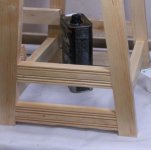I’m planning a project in which I’ll be using Domino 500 joinery. I’m fortunate to belong to a woodworking group that has equipment that exceeds the capacities of my shop and includes a Domino.
My question has to do with the advisability of pre-finishing the parts in advance of using the Domino to create the mortises. Basically I would first apply danish oil and a barrier coat of shellac, cut the mortises, glue up the assembly on the tenon faces and mortise cheeks only, scuff sand and then spray multiple coats of lacquer.
My initial research suggests that there is little or nothing to be gained by glueing the shoulders and I’m interested in learning if there are any other considerations.
Thanks in advance.
My question has to do with the advisability of pre-finishing the parts in advance of using the Domino to create the mortises. Basically I would first apply danish oil and a barrier coat of shellac, cut the mortises, glue up the assembly on the tenon faces and mortise cheeks only, scuff sand and then spray multiple coats of lacquer.
My initial research suggests that there is little or nothing to be gained by glueing the shoulders and I’m interested in learning if there are any other considerations.
Thanks in advance.




